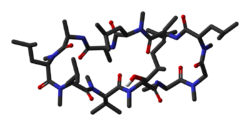Ciclosporin, cyclosporine (USAN) or cyclosporin (former BAN), is an immunosuppressant drug widely used in post-allogeneic organ transplant to reduce the activity of the patient's immune system and so the risk of organ rejection. It has been studied in transplants of skin, heart, kidney, liver, lung, pancreas, bone marrow and small intestine. Initially isolated from a Norwegian soil sample, Ciclosporin A, the main form of the drug, is a cyclic nonribosomal peptide of 11 amino acids (an undecapeptide) produced by the fungus Tolypocladium inflatum Gams, and contains D-amino acids, which are rarely encountered in nature.
Indications
The immuno-suppressive effect of cyclosporin was discovered on January 31, 1972, by employees of Sandoz (now Novartis) in Basel, Switzerland, in a screening test on immune-suppression designed and implemented by Dr.Hartmann F. Stähelin, M.D. The success of Cyclosporin A in preventing organ rejection was shown in liver transplants performed by Dr. Thomas Starzl at the University of Pittsburgh hospital. The first patient, on March 9, 1980, was a 28-year-old woman. Cyclosporin was subsequently approved for use in 1983.
Apart from in transplant medicine, cyclosporin is also used in psoriasis, severe atopic dermatitis and infrequently in rheumatoid arthritis and related diseases, although it is only used in severe cases. It has been investigated for use in many other autoimmune disorders. Cyclosporin has also been used to help treat patients with ulcerative colitis who do not respond to treatment with steroids. This drug is also used as a treatment of posterior or intermediate uveitis with non-infective etiology.
Cyclosporin A has been investigated as a possible neuroprotective agent in conditions such as traumatic brain injury, and has been shown in animal experiments to reduce brain damage associated with injury. Cyclosporin A blocks the formation of the mitochondrial permeability transition pore, which has been found to cause much of the damage associated with head injury and neurodegenerative diseases.
Mode of action
Cyclosporin is thought to bind to the cytosolic protein cyclophilin (immunophilin) of immunocompetent lymphocytes, especially T-lymphocytes. This complex of ciclosporin and cyclophylin inhibits calcineurin, which under normal circumstances is responsible for activating the transcription of interleukin-2. It also inhibits lymphokine production and interleukin release and therefore leads to a reduced function of effector T-cells. It does not affect cytostatic activity.
It also has an effect on mitochondria. Cyclosporin A prevents the mitochondrial PT pore from opening, thus inhibiting cytochrome c release, a potent apoptotic stimulation factor. However, this is not the primary mode of action for clinical use but rather an important effect for research on apoptosis.
Biosynthesis
Cyclosporine A is synthesized by a nonribosomal peptide synthetase, cyclosporine synthetase. The enzyme contains an adenylation domain, thiolation domain, condensation domain, and an N-methyltransferase domain. The adenylation domain is responsible for substrate recognition and activation. While the thiolation domain covalently binds the adenylated amino acids to phosphopantetheine and the condensation domain elongates the peptide chain. Cyclosporine synthetase substrates includes: L-Valine, L-Leucine, L-Alanine, L-Glycine, 2-aminobutyric acid, 4-methylthreonine, and D-Alanine. With the adenylation domain, cyclosporine synthetase generates the acyl adenylated amino acids then covalently binds the amino acid to phosphopantetheine through a thioester linkage. Some of the amino acid substrates become N-methylated by S-adenosylmethionine. The cyclization step releases cyclosporine A from the enzyme. Amino acids such as D-Ala and butenyl-methyl-L-threonine indicates that cyclosporine synthetase requires the action of other enzymes such as a D-Alanine racemase. The racemization of L-Ala to D-Ala is PLP dependent. The formation of butenyl-methyl-L-threonine is performed by a butenyl-methyl-L-threonine polyketide synthase that utilizes acetate/malonate as its starting material.
Adverse Effects and Interactions
Treatment may be associated with a number of potentially serious adverse drug reactions (ADRs) and adverse drug interactions. Ciclosporin interacts with a wide variety of other drugs and other substances including grapefruit juice. There have been studies into the use of grapefruit juice to increase the blood level of cyclosporin.
ADRs can include gum hyperplasia, convulsions, peptic ulcers, pancreatitis, fever, vomiting, diarrhea, confusion, breathing difficulties, numbness and tingling, pruritus, high blood pressure, potassium retention and possibly hyperkalemia, kidney and liver dysfunction (nephrotoxicity & hepatotoxicity), and obviously an increased vulnerability to opportunistic fungal and viral infections.
An alternate form of the drug, ciclosporin G (OG37-324), has been found to be much less nephrotoxic than the standard ciclosporin A. Ciclosporin G (Mol. mass 1217) differs from ciclosporin A in the amino acid 2 position, where an L-nor-valine replaces the α-aminobutyric acid.
Formulations
The drug is marketed by Novartis under the brand names Sandimmune, the original formulation, and Neoral for the newer microemulsion formulation. Generic ciclosporin preparations have been marketed under various trade names including Cicloral (Sandoz/Hexal) and Gengraf (Abbott). Since 2002 a topical emulsion of ciclosporin for treating keratoconjunctivitis sicca has been marketed under the trade name Restasis. Annual sales of ciclosporin are around $1 billion.
The drug is also available in a dog preparation manufactured by Novartis called Atopica. Atopica is indicated for the treatment of atopic dermatitis in dogs. Unlike the human form of the drug, the lower doses used in dogs mean the drug acts as an immuno-modulator and has fewer side effects than in man. The benefits of using this product include the reduced need for concurrent therapies to bring the condition under control.















No comments:
Post a Comment